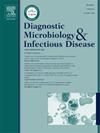Co-infection of lophomonas blattarum and mycobacterium tuberculosis: Insights from a study in northeastern Iran
IF 1.8
4区 医学
Q3 INFECTIOUS DISEASES
Diagnostic microbiology and infectious disease
Pub Date : 2025-08-18
DOI:10.1016/j.diagmicrobio.2025.117072
引用次数: 0
Abstract
Background
Pulmonary tuberculosis (TB) continues to pose a significant global health challenge, especially in low- and middle-income countries. The immune suppression caused by TB increases susceptibility to secondary infections such as Lophomonas blattarum, a rare protozoan that infects the respiratory tract. Co-infection with Lophomonas can complicate TB treatment due to overlapping symptoms, leading to misdiagnosis or delayed care. This study aims to assess the prevalence and clinical impact of L. blattarum co-infection in TB patients and evaluate the need for routine screening in regions with high TB prevalence.
Methods
This cross-sectional study was conducted in a tertiary care hospital in Mashhad, Iran. Bronchoalveolar lavage (BAL) samples were obtained from 214 patients with respiratory symptoms. TB diagnosis was based on Ziehl-Neelsen staining, culture as the gold standard, and polymerase chain reaction (PCR) targeting the IS6110 and 16S rRNA genes. L. blattarum detection was initially performed through direct light microscopy, and PCR was subsequently attempted using species-specific primers targeting the 18S rRNA gene. Data were analyzed using SPSS version 22, with p-values < 0.05 considered statistically significant.
Results
Of the TB-positive patients, 55.7 % were co-infected with Lophomonas, compared to 29.9 % in the TB-negative group, demonstrating a significant association between TB and Lophomonas infection (p < 0.001). The highest prevalence of Lophomonas infection was observed in patients over 60 years old. Despite molecular attempts to identify Lophomonas using PCR, the results were inconclusive, and microscopy served as the primary diagnostic tool.
Conclusion
The high rate of Lophomonas co-infection in TB patients underscores the need for routine screening, particularly in regions with high TB prevalence. Early detection of co-infections can improve patient outcomes and prevent complications from misdiagnosis or delayed treatment.
blattarum和结核分枝杆菌的共同感染:来自伊朗东北部研究的见解
背景肺结核(TB)继续构成重大的全球卫生挑战,特别是在低收入和中等收入国家。结核病引起的免疫抑制增加了继发性感染的易感性,例如blattarum(一种感染呼吸道的罕见原生动物)。由于症状重叠,与Lophomonas合并感染可使结核病治疗复杂化,导致误诊或延误治疗。本研究旨在评估blattarum合并感染在结核病患者中的流行情况和临床影响,并评估在结核病高流行地区进行常规筛查的必要性。方法本横断面研究在伊朗马什哈德的一家三级保健医院进行。对214例有呼吸道症状的患者进行支气管肺泡灌洗(BAL)。TB诊断基于Ziehl-Neelsen染色,培养为金标准,针对IS6110和16S rRNA基因进行聚合酶链反应(PCR)。blattarum的检测最初是通过直接光学显微镜进行的,随后使用针对18S rRNA基因的物种特异性引物进行PCR检测。数据采用SPSS version 22进行分析,p值<; 0.05认为有统计学意义。结果结核阳性患者中,55.7%的患者同时感染Lophomonas,而结核阴性患者中这一比例为29.9%,结核与Lophomonas感染之间存在显著相关性(p < 0.001)。60岁以上的患者中单胞菌感染率最高。尽管分子尝试识别Lophomonas使用PCR,结果是不确定的,显微镜作为主要的诊断工具。结论结核病患者中Lophomonas合并感染的高发率强调了常规筛查的必要性,特别是在结核病高流行地区。早期发现合并感染可改善患者预后,防止误诊或延误治疗引起的并发症。
本文章由计算机程序翻译,如有差异,请以英文原文为准。
求助全文
约1分钟内获得全文
求助全文
来源期刊
CiteScore
5.30
自引率
3.40%
发文量
149
审稿时长
56 days
期刊介绍:
Diagnostic Microbiology and Infectious Disease keeps you informed of the latest developments in clinical microbiology and the diagnosis and treatment of infectious diseases. Packed with rigorously peer-reviewed articles and studies in bacteriology, immunology, immunoserology, infectious diseases, mycology, parasitology, and virology, the journal examines new procedures, unusual cases, controversial issues, and important new literature. Diagnostic Microbiology and Infectious Disease distinguished independent editorial board, consisting of experts from many medical specialties, ensures you extensive and authoritative coverage.

 求助内容:
求助内容: 应助结果提醒方式:
应助结果提醒方式:


